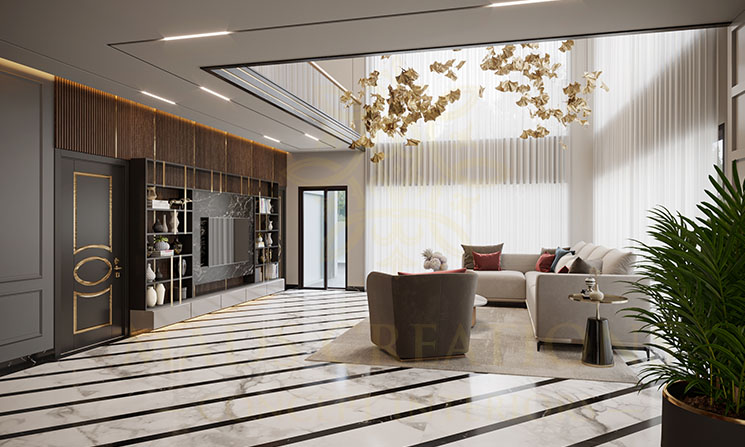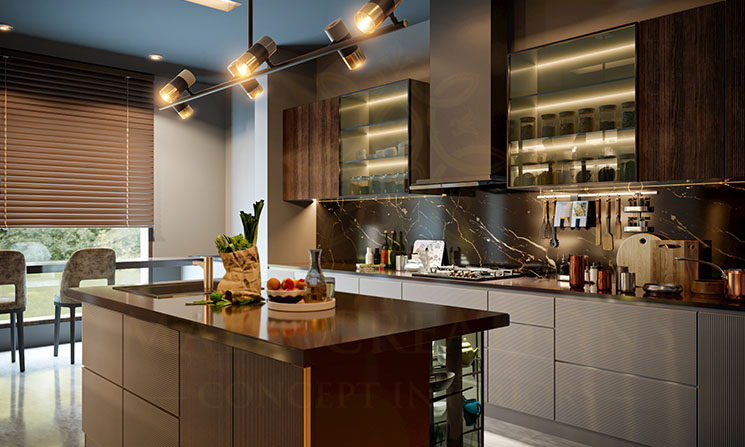Wood is an age-old material that has been used in interiors for centuries. Especially for furniture, it is still the most sought-after material. As a natural material, it brings a quintessential character and richness into the spaces, making it hard to substitute. Wood also spells warmth and naturalness, evoking cosy and inviting atmospheres.
While traditionally in India, wood was mostly used for doors, windows, furniture and ceilings, wooden flooring has gained popularity over the decades. Some southern states have homes and temples built entirely of wood, which, in the modern times has become a rarity due to the high cost and sustainability factors involved.
However, with the advent of veneers and laminates, today, wood tones are finding many more new applications in urban homes such as wall and ceiling panelings, and furniture surfaces. An unbelievable array of tones, hues and grains available on the market is both heartening and challenging as the task of mixing wood tones arises. Wooden flooring, with a wide range of finishes, has also caught on in India imparting a refined and luxurious look to environments. So a number of wood tones with different grains and stains are being used within a space.
This drives home the importance of understanding the art of mixing wood tones to great effect in an interior. Using a uniform wood tone could make the interiors look monotonous – too much matching always runs the risk of making a place boring and mundane. At the same time, too many different wood tones combined in a space without an eye for balance and harmony can look jarring.
So it is essential to be aware of the rules of layering different wood tones to evoke visual interest and dynamism in a space. Purposefully mixing wood tones with meticulous attention to details yields great results. This can be done either choosing tones that complement one another or offer stark contrasts. Or you can go for gradient tones from light to intermediate to dark. It is also imperative to have an idea of the characteristics of different wood tones. While generally wood is considered warm, some tones like black, charcoal and grey unleash a cool vibe.
Here we bring some tips to master the art of mixing different wood tones:
1. Determine the Main Wood Tone

Since wall paneling, ceiling décor and flooring are the most visible features, choose your favourite wood for either of them so that it sets the tone for the rest of the space. You can then go for diverse tones for furniture pieces and décor accessories that complement your main tone with their colour or finish. Sometimes, different tones with the same matte finish or high-gloss finish can work well together.
2. Take Care of the Placement

When blending wood tones, bringing like finishes or hues in close proximity will solve half the problem of balancing the diverse looks. If you have a darker tone for wall paneling, place a wooden cabinet that complements it so that they look in sync together. Also, furniture pieces made of woods of similar tones or matching hues look good together. Combine them to form a coherent seating arrangement.
3. Contrast with Care

In any interior, contrasting colours, textures and tones is essential to achieve a visually vibrant environment. Same with wood tones too. If you have too much of the same dark tone, the space could appear heavy. Too light could feel sterile. Pairing dark tones against light, and vice-a-versa, is a no-brainer, it always works well. And it works with wood tones too. Stark contrast sometimes can throw up dramatic results. Lighter contrasts have a sublime effect and can make the space feel seamless.
4. Small Grains Ensure a Refined Look

If you are a fan of the sophisticated appeal wood brings to a space, look no further than woods with small grains. They immediately imbue the environment with a polished look. If you have to blend different woods, you can use contrasts or complementing tones and grains, and yet keep the environment clean and sublime.
Also Read – 7 Trending Ideas for your Luxury Modern Apartments
5. Be Casual with Large Grains

When you are looking to evoke a casual or rustic look, woods with large grains are your best bet. These can be used either for flooring or walls or ceiling. Whether it is farmhouse design or villa interiors, using open grain wood in informal spaces helps inject a sense of laidback luxury and charm. You can then combine furniture pieces and accessories of the same colour as the grain. It ensures tonal continuity.
6. Repeat the Tones

While working with several wood tones, defining the main tone can be a daunting task, resulting in a messy look. This could be the case especially when you are using smaller items. One solution lies in repeating the tones at least twice in order to tie them together. For example, pair at least one décor object or a floor lamp of the same tone as your furniture to maintain uniformity. Similarly, repeat the tone of your wall paneling with a similar toned mirror frame or a small furniture piece or an accessory. This helps in bringing the space together even while there are several colour tones under play.
7. Refrain from Scattering Tones

When you are already facing the challenge of bringing in harmony in a space using diverse woods, the least you can do is refrain from scattering them all over the place. That would be jarring to the eye. Try to bring like tones and finishes together so that they look like they belong with each other. This helps in building cohesiveness as it casts focus on the likeness of elements.
As a leading interior design firm in Gurgaon, MADS Creations vouches for the warmth and richness wood brings to interiors. We use them extensively by combining disparate tones and also with other materials. While teak wood is our go-to material for furniture, the availability of an extensive range of veneers and laminates is an attractive option for creating wall panelings, ceiling décor and furniture. And of course, nothing beats the refined elegance of wooden flooring, which is an inevitable choice for our luxury projects that vary from apartments to penthouses, from villas to farmhouses. Scroll down our Instagram posts to find inspirations for innovative blends of wood tones that lend a unique character and texture to the spaces we design


